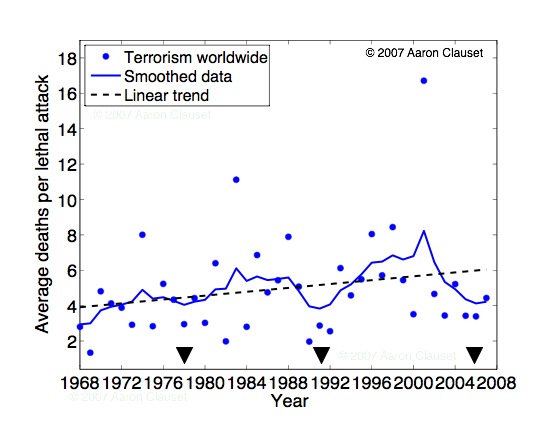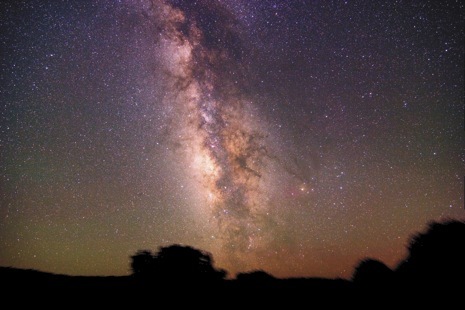« August 2007 | Main | October 2007 »
September 26, 2007
Workshop: NSF + IPAM on CDI grant
IPAM is running a short workshop at the end of October to discuss a newly announced NSF program with the unfortunate name of "Cyber-Enabled Discovery and Innovation" (or, CDI). Although its relationship to networks may not be obvious from the title, it seems clear to me (and to IPAM) that networks are going to be a big part of what CDI funds.
I think the general idea is to give NSF feedback about what are the interesting questions and topics in this area, and to let the community of interested folks get some feedback about what NSF is looking for. Seems like a reasonable idea to me, and could be a good opportunity to interact with both NSF and other folks interested in the grant.
Cyber-Enabled Discovery and Innovation: Knowledge Extraction; October 29, 2007 at IPAM.
posted September 26, 2007 08:10 AM in Conferences and Workshops | permalink | Comments (0)
September 24, 2007
New Math
This wasn't how I learned how to do basic arithmetic, but it sure is entertaining when sung like this.
(tip to David)
posted September 24, 2007 07:19 PM in Humor | permalink | Comments (0)
September 23, 2007
DIMACS Workshop on Computational Methods for Dynamic Interaction Networks
For the first part of this week I'm at Rutgers University giving a talk on analyzing dynamic social network data (really, dynamic proximity data from which you can infer network data) at a DIMACS workshop run in part by Tanya Berger-Wolf (now at UIC; I first met her when she was a post-doc at UNM). Some of the presentations overlap with those I saw at another DIMACS workshop back in January at GA Tech, but I hope the emphasis in this event will be more on dynamic (i.e., temporally varying) networks, and some of the interesting questions you can answer computationally with that kind of data.
Then, I'll be spending the rest of the week in New York City thinking about science with Chris and Jake at Columbia.
posted September 23, 2007 09:24 PM in Conferences and Workshops | permalink | Comments (0)
September 12, 2007
Is terrorism getting worse? A look at the data. (part 2)
Cosma and Matt both wanted to see how the trend fares when we normalize by the increase in world popluation, i.e., has terrorism worsened per capita. Pulling data from the US Census's world population database, we can do this. The basic facts are that the world's population has increased at a near constant rate over the past 40 years, going from about 3.5 billion in 1968 to about 6.6 billion in 2007. In contrast, the total number of deaths per year from terrorism (according to MIPT) has gone from 115 (on average) over the first 10 years (1968 - 1977), to about 3900 (on average) over the last 10 years (1998 - 2007). Clearly, population increase alone (about a factor of 2) cannot explain the increase in total deaths per year (about a factor of 34).
However, this view gives a slightly misleading picture because the MIPT changed the way it tracked terrorism in 1998 to include domestic attacks worldwide. Previously, it only tracked transnational terrorism (target and attackers from different countries), so part of the the apparent large increase in deaths from terrorism in the past 10 years is due to simply including a greater range of events in the database. Looking at the average severity of an event circumvents this problem to some degree, so long as we assume there's no fundamental difference in the severity of domestic and transnational terrorism (fortunately, the distributions pre-1998 and post-1998 are quite similar, so this may be a reasonable assumption).
The misleading per capita figure is immediately below. One way to get at the question, however, is to throw out the past 10 years of data (domestic+transnational) and focus only on the first 30 years of data (transnational only). Here, the total number of deaths increased from the 115 (on average) in the first decade to 368 in the third decade (1988-1997), while the population increased from 3.5 billion in 1968 to 5.8 billion in 1997. The implication being that total deaths from transnational terrorism have increased more quickly than we would expect based on population increases, even if we account for the slight increase in lethality of attacks over this period. Thus, we can argue that the frequency of attacks has significantly increased in time.

The more clear per capita-event figure is the next one. What's remarkable is that the per capita-event severity is extremely stable over the past 40 years, at about 1 death per billion (dpb) per event. This suggests that, if there really has been a large increase in the total deaths (per capita) from terrorism each year (as we argued above), then it must be mainly attributable to an increase in the number of lethal attacks each year, rather than attacks themselves becoming worse.
So, is terrorism getting worse? The answer is typically no, but that terrorism is becoming a more popular mode of behavior. From a policy point of view, this would seem a highly problematic trend.

A. Clauset, M. Young and K. S. Gledistch, "On the Frequency of Severe Terrorist Attacks." Journal of Conflict Resolution 51(1): 58 - 88 (2007).
posted September 12, 2007 08:12 AM in Political Wonk | permalink | Comments (2)
September 11, 2007
Is terrorism getting worse? A look at the data.
Data taken from the MIPT database and includes all events that list at least one death (10,936 events; 32.3% as of May 17, 2007). Scatter points are the average number of deaths for lethal attacks in a given year. Linear trend has a slope of roughly 1 additional death per 20 years, on average. (Obviously, a more informative characterization would be the distribution of deaths, which would give some sense of the variability about the average.) Smoothing was done using an exponential kernel, and black triangles indicate the years (1978, 1991 and 2006) of the local minima of the smoothed function. Other smoothing schemes give similar results, and the auto-correlation function on the scatter data indicates that the average severity of lethal attacks oscillates with a roughly 13 year periodicity. If this trend holds, note that 2006 was a low-point for lethal terrorism.

A. Clauset, M. Young and K. S. Gledistch, "On the Frequency of Severe Terrorist Attacks." Journal of Conflict Resolution 51(1): 58 - 88 (2007).
posted September 11, 2007 10:33 AM in Political Wonk | permalink | Comments (3)
Announcement: NetSci 2008
It seems like NetSci is gaining some momentum as an annual thing, and this seems like good news to me. I hope this also means that the conference will exhibit greater diversity in the speakers, which in the past has tilted heavily toward the past and present collaborators of the organizers. The bad news for State-siders like me is that NetSci 2008 is going to be in the UK, which makes attending a little more complicated (actually, the last I'd heard, it was going to be in Italy). The website has scant details at the moment, so I will probably post again about this conference closer to the submission deadline.
International Conference on Network Science 2008 (NetSci)
June 25 - 27, 2008 at Norwich BioSciences Conference Centre, Norwich, UK
Organizers: Norwich BioSciences Conference Centre and David White (Institute of Food Research, IFR), József Baranyi (IFR), Guido Caldarelli (University of Rome), Zoltán Toroczkai (Notre Dame), and Albert-László Barabási (Notre Dame).
posted September 11, 2007 10:06 AM in Conferences and Workshops | permalink | Comments (0)
September 09, 2007
Losing the night sky
Last week I read an excellent article by David Owen in The New Yorker about light pollution, and the phenomenon of "sky glow". Living in New Mexico, I'm lucky to have relatively dark night skies compared to places on the coasts where light from the big cities consistently washes out most of the stars in the sky. But, the New Mexican sky (pictured below, in a long exposure; picture taken from the article) is not nearly as dark as the sky I remember in central Belize where it was so dark that you could see both man-made satellites passing overhead (these are easy to spot because of their slow but constant movements), as well as the magnificent Milky Way. To think that most views of the night sky were like that is a bit mind boggling.
The article is well written, describing the general phenomenon of light pollution and its effects, the grass-roots efforts by people to try to cut down on light pollution from cities, the effects of poor outdoor lighting design on local ecologies, human safety and power consumption, etc. What most piqued my interest though was the idea that losing our night skies to light pollution (for instance, light from Las Vegas dims the stars in the sky as far away as the Grand Canyon) has led to a loss of philosophical perspective of our place in the universe. From the introduction to the article:
In Galileo’s time, nighttime skies all over the world would have merited the darkest Bortle ranking, Class 1. Today, the sky above New York City is Class 9, at the other extreme of the scale, and American suburban skies are typically Class 5, 6, or 7. The very darkest places in the continental United States today are almost never darker than Class 2, and are increasingly threatened.  For someone standing on the North Rim of the Grand Canyon on a moonless night, the brightest feature of the sky is not the Milky Way but the glow of Las Vegas, a hundred and seventy-five miles away. To see skies truly comparable to those which Galileo knew, you would have to travel to such places as the Australian outback and the mountains of Peru. And civilization’s assault on the stars has consequences far beyond its impact on astronomers. Excessive, poorly designed outdoor lighting wastes electricity, imperils human health and safety, disturbs natural habitats, and, increasingly, deprives many of us of a direct relationship with the nighttime sky, which throughout human history has been a powerful source of reflection, inspiration, discovery, and plain old jaw-dropping wonder.
For someone standing on the North Rim of the Grand Canyon on a moonless night, the brightest feature of the sky is not the Milky Way but the glow of Las Vegas, a hundred and seventy-five miles away. To see skies truly comparable to those which Galileo knew, you would have to travel to such places as the Australian outback and the mountains of Peru. And civilization’s assault on the stars has consequences far beyond its impact on astronomers. Excessive, poorly designed outdoor lighting wastes electricity, imperils human health and safety, disturbs natural habitats, and, increasingly, deprives many of us of a direct relationship with the nighttime sky, which throughout human history has been a powerful source of reflection, inspiration, discovery, and plain old jaw-dropping wonder.
More information at the International Dark-Sky Association (IDA), including information about lighting fixtures that can both reduce light pollution and save energy, lighting laws and dark-sky activities in parks in preserves.
posted September 9, 2007 01:19 PM in Things to Read | permalink | Comments (0)